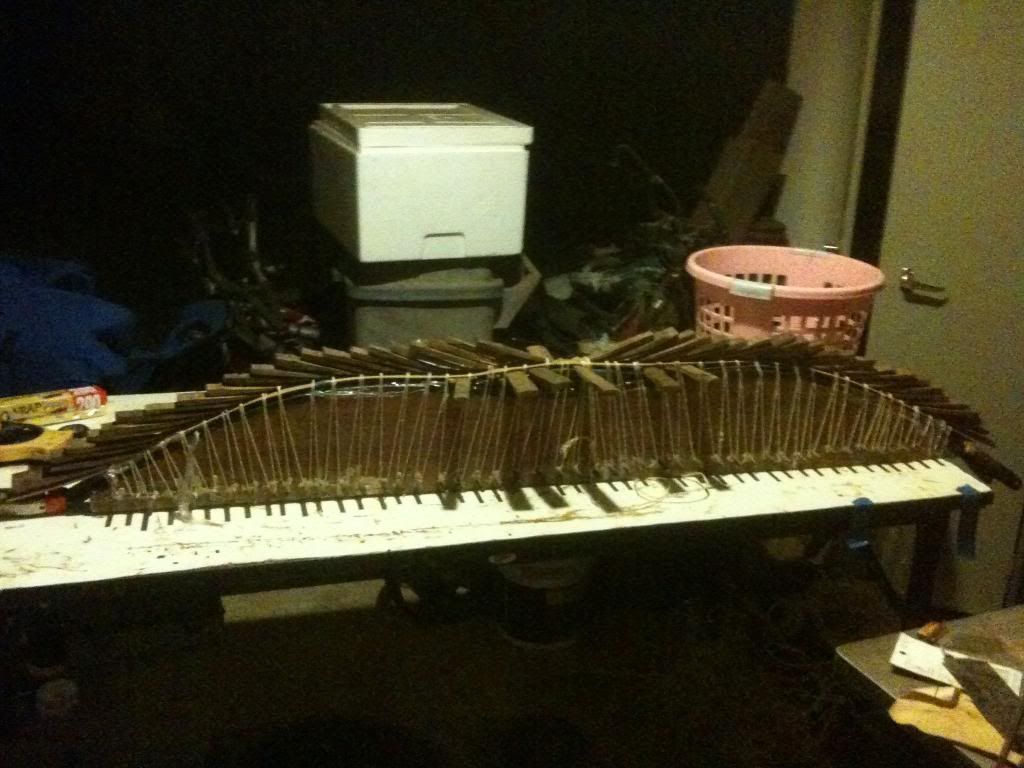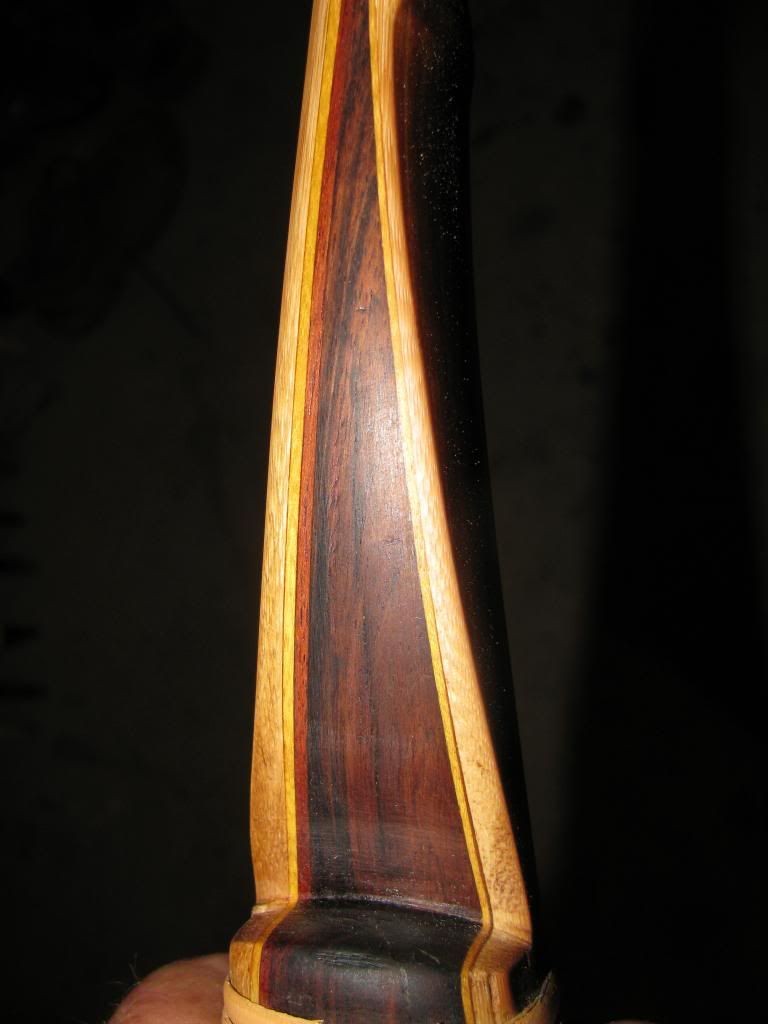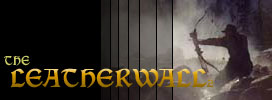| From: Echatham
|
|
|
|
|
|
|
| Date: 14-Feb-13 |
|
Whats in your bow building shop as far as tools go? what do you consider "essential" and whats just "nice to have"? Pictures would be great! Im wanting to try building some laminated bows in the future, so im slowly... so slowly... aquiring the things i will need. I plan on buying a kit from bingham projects to start with once i have all the hardware i need.
|
|
| From: Glunt@work
|
|
|
|
|
|
|
| Date: 14-Feb-13 |
|
Here's what I use:
Table saw
14" band saw
Disc/belt combo sander
Spindle sander
Dremel
Router (form building)
Orbital hand sander
Assorted hand tools
Lots of clamps
Compressor
Like to have:
Thickness sander for making lams
Big edge sander like 48"
You don't "need" a lot of stuff but power tools sure save time.
|
|
| From: wildman
|
|
|
|
|
|
|
| Date: 14-Feb-13 |
|
Glunt@work has it about covered,one of my tools that I love is a power file,its a hand held 1x12 belt sander.
|
|
| From: Echatham
|
|
|
|
|
|
|
| Date: 14-Feb-13 |
|
could i get the whole job done with just a dremel, a palm sander, a 14" bandsaw and a belt/disc sander combo? anxious to build a bow, and the only thing on my list i don't have yet is the band saw.... but its next.
|
|
| From: bradsmith2010
|
|
|
|
|
|
|
| Date: 14-Feb-13 |
|
i made a few bows from bingham kits along time ago,, and they shot well,,, my tools were minimal,,,making the form was the most difficult part for me,,,not making the bow,,,
|
|
| From: Jeff Durnell
|
|
|
|
|
|
|
| Date: 14-Feb-13 |
|
You don't need a disc/belt sander, a dremel or a palm sander. I've made a bunch of bows and never used any of them.
If you plan on making more that a few laminated bows, here's my list of essentials... from bandsaw to pencils :)
Essential: 14" band saw, drum sander(needed for feathering out the ends of riser/handle pieces and I also use it a lot for cleaning up the limb edges, trapping them, and shaping the handle, table saw(for squaring up riser blocks and cutting them to width), 6" sturdy bench vice w/padding for jaws, 7-8' flat workbench, bow press, hot box or heat strips, sand paper 60-240 grit, assorted files and rasps(I use a lot of doublecut bastard and smooth files of various sizes and shapes), 4" Nicholson rattail and/or chainsaw file for string nocks and grooves, spring clamps for holding patterns to bow blanks, several 2-6" c- clamps and several 18" or so pipe and/or bar clamps for overlays and clamping multiple piece riser blocks together, tape measure, toothing plane blade for prepping gluing surfaces, straight edges(aluminum yardsticks see a lot of use), latex gloves, solvents such as acetone, lacquer thinner, denatured alcohol, pencils, sharpie permanent markers. Others may not, but I also consider a compressor and a spray gun essential for a professional quality finish... but you can get by with aerosol can spray finish or something.
Nice to have: shop vac, power miter saw, jointer, disc/belt sander combo, 18" thickness sander and adjustable lam sled for grinding lams(hey, ya might as well dream big:), tillering tree(they're not only useful for selfbows, it's nice to see how a glassbow's limbs work too so that you can see where adjustments need made in lam taper, limb profile, etc), smooth side of a big farrier's rasp works well in a few places on laminated bows, and last but not least.... a kickass ipod docking station and a well-stocked beer fridge :)
Note: I went through two oscillating spindle sanders plus one additional motor assembly before I gave up on them. Instead, I bought a cheap floor model drill press and put a sanding drum on it. It doesn't oscillate, but I don't miss that feature at all, and now I have a drill press too... two major tools for the price of one. It has outlasted the spindle sanders and shows no signs of wear or failing in any way. The drill press has a bigger motor, stronger bearings, and the debris falls away from the bearings, not into them.
p.s. start saving tuna fish cans and popsicle sticks for mixing glue
p.s.s various tools can accomplish some of the same tasks, so some choices are personal preferences. What I consider 'essential'... others may consider unnecessary.
I'd show you some pics of my shop but it's trashed right now. I plan on straightening things up there this weekend, so maybe afterwards if I have any strength left :^)
|
|
| From: Gaur
|
|
|
|
|
|
|
| Date: 14-Feb-13 |
|
my three big tools are a belt sander, band saw and a drum sander (for making laminations)
Other ones that are helpful,
nice scrappers for shaping selfbows, heat gun for corrections files from coarse to pretty fine
|
|
| From: tbhuntr
|
|
|
|
|
|
|
| Date: 14-Feb-13 |
|
I have a Drum sander with 3/4' 1 1/2, and 3 inch drums. A band saw (at work) and a belt sander. I do a lot of the major roughing with the drum sander, but my favorite tool is a half round file and a big flat bastard file. I do almost all of my finishing and getting my limb edges straight with the files. In my opinion those two files are my most essential tools. Then lots of hand sanding !!!!
|
|
| From: Harp
|
|
|
|
|
|
|
| Date: 14-Feb-13 |
|
Well my most used tools are 14" bandsaw, small bench top belt disc sander (wish someone made one of these with a motor with some a$$), a floor model drill press with 3" sanding drum, a rotozip tool with flexible shaft(dremels are junk now adays) and a 1/6th sheet palm sander made by Ryobi (no longer made). I also have a 6"x 48" belt disc sander, a drum sander that I use too. Then theres C clamps, spring clamps, files, 6" machinest square, mic and then theres the sandpaper. Stock up on sandpaper and treat it like you stole it. Most folks spend way to much time hand sanding with worn out sand paper!
|
|
| From: Echatham
|
|
|
|
|
|
|
| Date: 14-Feb-13 |
|
so if im not making the laminations at first... i can get by with a belt and disc sander, a bandsaw, and all the misc hand tools right?
|
|
| From: bowyer45
|
|
|
|
|
|
|
| Date: 15-Feb-13 |
|
My first recurves were built with rasps, files and sandpaper and a square (and sweat), the use of a band saw for the form is nice but a jig saw will work.The old timers used a hacksaw with the blade turned sideways. Power tools make it allot easier of course, but depending on your skill etc not 100% necessary. If you're half way handy you can rough out a bow with hand held 9" metal grinder. This is real sculpchering, kind of like chainsaw art. now I have many thousands of dollars of equipment to build bows and furnature and about anything else, but I still like the grinder for roughing out the glued up blank and getting close to the line etc. A good laminated bow always is dependant on a good form, it needs to be perfect, so don't short cut on it. A good solid work table and vise of course. Good luck and start with a kit from Binghams will help also. Oh and the cheapest method for the glueup is to use inner tube strips to apply pressure to the lams for glueup. Its all you need to make a good bow, if you don't have the clamps or hose setups. Years ago, I made many bows that way and they are still shooting 30 yrs later today. Not sure if that is the info you wanted but power tools take up allot of room and many don't have the room. jmho
|
|
| From: Glunt@work
|
|
|
|
|
|
|
| Date: 15-Feb-13 |
|
Absolutely you can get it done with what you have. I saw a build-along from a guy in Asia that made some very nice takedown recurves and his only power tool was a sander.
|
|
| From: Echatham
|
|
|
|
|
|
|
| Date: 15-Feb-13 |
|
bowyer45 and Glunt, Thanks! hey most of the buildalongs i have seen used the clamps, or the hose... how heavy and how big do i want the clamps? i found a good deal on a thirty pack of 3" jawed 50# of pressure spring clamps that look like what i have seen in the build alongs, but im not sure what the specs on theirs were. how much pressure do i want and if clamps are a good way, what kind of spacing do i want?
|
|
| From: foxwhelp
|
|
|
|
|
|
|
| Date: 15-Feb-13 |
|
Dude...if you are not making laminated bows you dont need all those expensive power tools. Dozens and dozens have been turned out in my shop and not one ever touched a power tool. Hand saws, most have forgotten how to use one, let alone sharpen it. Fariers rasp, nicholson #50, cabinet scrapers, clamps. The wood doesn't want to be vibrated into oblivion and beaten up by all those electric mechanisms. Keep it simple and enjoy the slow process of turning a stave or board into a bow.
|
|
| From: Echatham
|
|
|
|
|
|
|
| Date: 15-Feb-13 |
|
foxwhelp Im talking about laminated bows. i agree with you about self bows... and ive built two with just a hatchet, draw knife, and rasps
|
|
| From: Gaur
|
|
|
|
|
|
|
| Date: 15-Feb-13 |
|
A belt sander is a pretty nice tool for shaping. I've seen diy lam grinders made with belt sanders that look like they work ok. Lam are getting so expensive. It is real nice to be able to make your own. A digital caliper is real nice when making your own lams.
If you don't want to do the air hose you can just do a form and have screws sticking out on the bottom and use large rubber bands or bicycle inner tubing to get decent glue lines. I like this wedge system too. Here is my bow I recently made. I used bamboo for the belly and back but the method also works for glass bows.   my glue lines. my glue lines.
|
|
| From: Sixby
|
|
|
|
|
|
|
| Date: 15-Feb-13 |
|
80inch belt ,profile line sander, Dust collection system, Disk sander, drum sander, orbital sanders, 2 14 in band saws, one 10 inch table saw, compressor,Heavy vice, dozens of clamps of every variety. long line hand sander, block sanders, files , dremels, 3 sets with every tool you can imagine. Carving tools m checkering tools, Drill press, drill press sanding attachments, sanding box. 20 gallon shop vac. I just know I am missing something here. LOl
god bless you all, steve
|
|
| From: Echatham
|
|
|
|
|
|
|
| Date: 15-Feb-13 |
|
guar that looks real good.... but im not sure whats going on there with the wedges... can you explain that to a dummy?
|
|
| From: Gaur
|
|
|
|
|
|
|
| Date: 15-Feb-13 |
|
put the twine over the bow going one way down to the screws. I have holes drilled and rebar glued into place on mine. Then when you get to the end come back the other way and each time you go over the bow you make an "X". You want to pull the twine real snug. Then take a wedge and work it into each X. Use a hammer tap the wedges. I also use a scrap piece of bamboo so the wedges don't come into direct contact with the bow. I added the wedges from the sides to get more pressure at the fades to close the gap better in those areas.
|
|
| From: Echatham
|
|
|
|
|
|
|
| Date: 15-Feb-13 |
|
ok so do you just get the wedges snugged up to even pressure by feel?
|
|
| From: Echatham
|
|
|
|
|
|
|
| Date: 15-Feb-13 |
|
ok here is a slight tangent to the thread.... my very next project is a hickory backed ipe board bow. after glue up... im gonna have a bow thats an inch and 3/4 (or maybe it was an inch and a half.. cant remember my board dimensions) from tip to tip..... what tool do you guys use to shape the limbs down to a half inch or whatever at the tips? i had gotten the impression that i needed a bandsaw... and should not try to use a draw knife for that. could i feasibly use the belt sander to get it to shape? rough it out with draw knife and clean it up with the sander? i guess the same question applies to a true laminated bow too.
|
|
| From: Gaur
|
|
|
|
|
|
|
| Date: 15-Feb-13 |
|
Yes you hit them in by feel and by looking at your glue lines.
You don't need a bandsaw. I use a good corse rasp. Working from the backing towards the belly so you don't raise a splinter on the backing. A belt sanders works good too if you have access to one.
|
|
| From: Echatham
|
|
|
|
|
|
|
| Date: 15-Feb-13 |
|
yah i just bought a belt/disc sander as my first power tool for the shop. i will use it for tapering fir shafts if nothing else.... kind of an expensive taper tool lol
|
|
| From: bowyer45
|
|
|
|
|
|
|
| Date: 16-Feb-13 |
|
The sander is very handy for tapering your wedges. Horse rasps work great for shaping risers etc, With the inner tube rubber bands the method yrs ago was wrap the whole form completely with two layers of bands. The pressure ended up being quite a bit and really made great glue joints. 1/4 inch rubber pads went over the top glass. Painters poly plastic works great to cover the form and also the top from the glue squeeze out. As for the clamp method I made my own again based on the way it was done in the forties. But some use big c clamps etc. If you use clamps you need to then have a top piece the shape of the mold. A flexable flat steel of 1/8 thickness with a 1/4 rubber pad is what I like. The rubber can be thick rubber gasket material and the steel cheaply bought from about any steel supply. The clamps need to be no more than 2 inches apart for straight runs, but closer in the tight bends and fadeout areas. If you want to make your own clamps you will need a welder and hacksaw and 1" wide by 1/8 inch strap. pm me if you want more info.
|
|
If you have already registered, please sign in now
For new registrations Click Here
|
|
|
|



